new zealand

 My sister-in-law, Jennifer Parmely has spent most of her adult life as a Labor and Delivery nurse at Wyoming Medical Center, but this past year, all that changed when Jennifer retired on February 28, 2023. Now, she has more than passed the first full year of her retirement. Sometimes, I wonder how she feels about the fact that she isn’t part of the intense, exciting daily deliveries of babies that she spent so many years experiencing. Like most professionals, Jennifer took the necessary continuing education courses to hold onto her license for one more year. When you have worked so hard to obtain that professional degree that has defined your life for so many years, you aren’t so keen on letting your licensing go. Not just yet…even though retirement is what you really want and what you have worked for.
My sister-in-law, Jennifer Parmely has spent most of her adult life as a Labor and Delivery nurse at Wyoming Medical Center, but this past year, all that changed when Jennifer retired on February 28, 2023. Now, she has more than passed the first full year of her retirement. Sometimes, I wonder how she feels about the fact that she isn’t part of the intense, exciting daily deliveries of babies that she spent so many years experiencing. Like most professionals, Jennifer took the necessary continuing education courses to hold onto her license for one more year. When you have worked so hard to obtain that professional degree that has defined your life for so many years, you aren’t so keen on letting your licensing go. Not just yet…even though retirement is what you really want and what you have worked for. 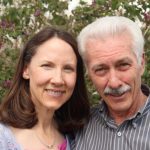
Jennifer and her partner, Brian Cratty have a cabin on Casper Mountain, and they love spending time up there. They go hiking, skiing, bicycling, and just enjoying the peace and quiet. They have also traveled to many areas to do more hiking. It is their passion. Jennifer had the opportunity to go hiking in New Zealand, and thoroughly enjoyed it. They have hiked some very high mountain trails too. They also love to ski, both downhill and cross country. They spend lots of time at their cabin and love having their kids come up too.
Jennifer is Oma to her four grandchildren and enjoys having them spend the night and just hang out. Every year on their birthdays, they each get a solo shopping trip with her, and she bakes them the cake of their choice. She loves being Oma, which is German for Grandma, and was the name she chose for herself as a way 
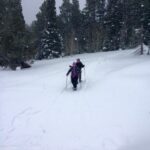 to keep from confusing the kids when they were little. I remember calling her “Grandma” to one of them, and she looked at me quizzically, as if to say…Who? That was because she knew that I meant her Oma, and not her Grandma, which is her other Grandma. Hahaha!! Confused yet!! I was, but I learned quickly the right thing to call her!! Now it’s second nature. Jennifer is very happy being Oma to her three granddaughters and her grandson. Today is Jennifer’s birthday. Happy birthday Jennifer!! Have a great day!! We love you!!
to keep from confusing the kids when they were little. I remember calling her “Grandma” to one of them, and she looked at me quizzically, as if to say…Who? That was because she knew that I meant her Oma, and not her Grandma, which is her other Grandma. Hahaha!! Confused yet!! I was, but I learned quickly the right thing to call her!! Now it’s second nature. Jennifer is very happy being Oma to her three granddaughters and her grandson. Today is Jennifer’s birthday. Happy birthday Jennifer!! Have a great day!! We love you!!
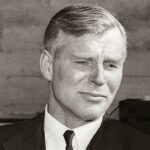
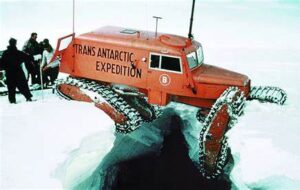 Over the centuries, there have been many exploratory expeditions all over the world. Some were privately financed, while others were financed by groups, governments, kings and as in the case of the 1955 to 1958 expedition to Antartica, the Commonwealth of England. The Commonwealth Trans-Antarctic Expedition (CTAE) was an expedition that successfully completed the first overland crossing of Antarctica, by way of the South Pole. It was also the first expedition to reach the South Pole overland for 46 years. t was preceded only by Amundsen’s expedition and Scott’s expedition in 1911 and 1912. Antartica is a fierce, snow and ice covered, wilderness, which makes me wonder why anyone would want to be on an expedition there. Nevertheless, I suppose that it’s the adventure of it that attracts so many to attempts it.
Over the centuries, there have been many exploratory expeditions all over the world. Some were privately financed, while others were financed by groups, governments, kings and as in the case of the 1955 to 1958 expedition to Antartica, the Commonwealth of England. The Commonwealth Trans-Antarctic Expedition (CTAE) was an expedition that successfully completed the first overland crossing of Antarctica, by way of the South Pole. It was also the first expedition to reach the South Pole overland for 46 years. t was preceded only by Amundsen’s expedition and Scott’s expedition in 1911 and 1912. Antartica is a fierce, snow and ice covered, wilderness, which makes me wonder why anyone would want to be on an expedition there. Nevertheless, I suppose that it’s the adventure of it that attracts so many to attempts it.
Traditionally, polar expeditions of the Heroic Age of Antarctic Exploration were private ventures, and the CTAE was no exception, even though it was supported by the governments of the United Kingdom, New Zealand, United States, Australia and South Africa, as well as many corporate and individual donations, under the patronage of Queen Elizabeth II. The expedition was headed by British explorer Vivian Fuchs and included New Zealander Sir Edmund Hillary. The group from New Zealand included scientists who were participating in International Geophysical Year research while the British team were separately based at Halley Bay.
Fuchs took the Danish Polar vessel, Magga Dan and went for additional supplied, returning in December 1956. The southern summer of 1956–1957 was spent consolidating Shackleton Base and establishing the smaller South Ice Base, located about 300 miles inland to the south. The winter of 1957 found Fuchs at Shackleton Base. Then, finally, he set out on the transcontinental journey in November 1957. The twelve-man team traveled in six vehicles, three Sno-Cats, two Weasel tractors, and one specially adapted Muskeg tractor. While they traveled, the team was also tasked with carrying out scientific research including seismic soundings and 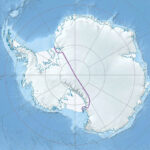 gravimetric readings. This was, after all a scientific expedition.
gravimetric readings. This was, after all a scientific expedition.
Hillary’s team began setting up Scott Base. This was going to be the final destination for Fuchs. It was located on the opposite side of the continent at McMurdo Sound on the Ross Sea. Using three converted Ferguson TE20 tractors and one Weasel, which had to be abandoned part-way, Hillary and his three men…Ron Balham, Peter Mulgrew, and Murray Ellis…were responsible for route-finding and laying a line of supply depots up the Skelton Glacier and across the Polar Plateau on towards the South Pole, for the use of Fuchs on the final leg of his journey. The remaining member of Hillary’s team carried out geological surveys around the Ross Sea and Victoria Land areas. The Hillary team was not originally supposed to travel as far as the South Pole, but when the supply depots were completed, Hillary saw the opportunity to beat the British and continued south, thereby reaching the Pole…where the US Amundsen–Scott South Pole Station had recently been established by air, on January 3, 1958. While he wasn’t supposed to go, Hillary’s party became the third team to reach the South Pole, preceded by Roald Amundsen in 1911 and Robert Falcon Scott in 1912. Hillary’s arrival also marked the first time that land vehicles had ever reached the Pole. It was a great historic moment.
Fuchs’ team finally reached the Pole from the opposite direction on January 19, 1958, where they met up with Hillary. From there, Fuchs continued overland, following the route that Hillary had forged to get to the South Pole. Then, Hillary flew back to Scott Base in a US plane. He would later rejoin Fuchs by plane for part of the remaining overland journey. The original overland party finally arrived at Scott Base on March 2, 1958, after having completed the historic crossing of 2,158 miles of previously unexplored snow and ice in 99 days. A few days later the expedition members left Antarctica on the on the New Zealand naval ship Endeavour, headed for New Zealand, with Captain Harry Kirkwood at the helm.
Although large quantities of supplies were hauled overland, many forms of resources were used in the expedition. Both parties were also equipped with light aircraft and made extensive use of air support for reconnaissance and supplies. US personnel working in Antartica at the time provided additional logistical help. Both parties also used dog teams for fieldwork trips and backup in case of failure of the mechanical transportation. The dogs were not taken all the way to the Pole. In December 1957 four men from the 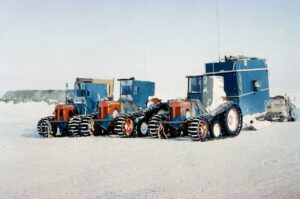
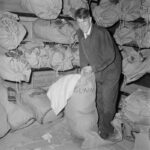 expedition flew one of the planes…a de Havilland Canada DHC-3 Otter—on an 11-hour, 1,430-mile, non-stop trans-polar flight across the Antarctic continent from Shackleton Base by way of the Pole to Scott Base, following roughly by air the same route as Fuchs’ overland party. For his accomplishments, Fuchs was knighted. The second overland crossing of the continent did not occur until 1981, during the Transglobe Expedition led by Ranulph Fiennes.
expedition flew one of the planes…a de Havilland Canada DHC-3 Otter—on an 11-hour, 1,430-mile, non-stop trans-polar flight across the Antarctic continent from Shackleton Base by way of the Pole to Scott Base, following roughly by air the same route as Fuchs’ overland party. For his accomplishments, Fuchs was knighted. The second overland crossing of the continent did not occur until 1981, during the Transglobe Expedition led by Ranulph Fiennes.
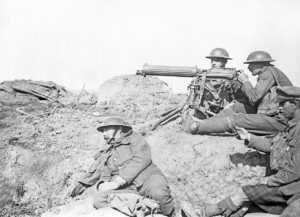 The dynamic of the world wars was probably different than most other wars…especially when it came to which units and countries were fighting side by side or against each other. When Britain declared war against Germany in August 1914, Australia was automatically also at war, because it was part of the British Empire. The New Zealand government (also under the sovereignty of the British Empire) followed without hesitation despite its geographic isolation and small population. The British Empire is for most of us, a difficult to understand group of countries that while largely independent, is also part of a larger government…the British Empire. The British Empire is a worldwide system of dependencies—colonies, protectorates, and other territories, that over a span of some three centuries was brought under the sovereignty of the crown of Great Britain and the administration of the British government. The policy of granting or recognizing significant degrees of self-government by dependencies, which was favored by the far-flung nature of the empire, led to the development by the 20th century of the notion of a “British Commonwealth” that was comprised of largely self-governing dependencies that acknowledged an increasingly symbolic British sovereignty. The term was embodied in statute in 1931. Today the Commonwealth includes former elements of the British Empire in a free association of sovereign states. Now, I don’t claim to understand the inner workings of the British Empire or the British Commonwealth, but Australia and New Zealand apparently had the option to join Britain in the war or to stand back and remain neutral. Both nations were loyal and joined Great Britain.
The dynamic of the world wars was probably different than most other wars…especially when it came to which units and countries were fighting side by side or against each other. When Britain declared war against Germany in August 1914, Australia was automatically also at war, because it was part of the British Empire. The New Zealand government (also under the sovereignty of the British Empire) followed without hesitation despite its geographic isolation and small population. The British Empire is for most of us, a difficult to understand group of countries that while largely independent, is also part of a larger government…the British Empire. The British Empire is a worldwide system of dependencies—colonies, protectorates, and other territories, that over a span of some three centuries was brought under the sovereignty of the crown of Great Britain and the administration of the British government. The policy of granting or recognizing significant degrees of self-government by dependencies, which was favored by the far-flung nature of the empire, led to the development by the 20th century of the notion of a “British Commonwealth” that was comprised of largely self-governing dependencies that acknowledged an increasingly symbolic British sovereignty. The term was embodied in statute in 1931. Today the Commonwealth includes former elements of the British Empire in a free association of sovereign states. Now, I don’t claim to understand the inner workings of the British Empire or the British Commonwealth, but Australia and New Zealand apparently had the option to join Britain in the war or to stand back and remain neutral. Both nations were loyal and joined Great Britain. 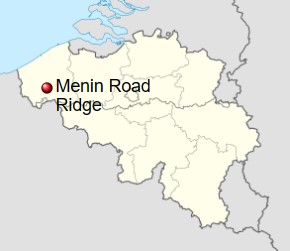
The Australian 6th Battalion was sent into warfare just two months after WWI began in August 1914. They met up with and joined the New Zealand Army, becoming the ANZAC (Australian and New Zealand Army Corps) from April 1915, while maintaining status as the Australian 6th Battalion until the unit was evacuated in December 1915. The Australian 6th Battalion fought German troops on the Western Front alongside the Allies. They were a good battalion, but for most of the time, there were no major decorations awarded…until. in September 1917, while serving in Belgium, Lieutenant Frederick Birks was awarded the only Victoria Cross ever granted within the unit. Sadly, Birks was killed in action the following day.
The Victoria Cross (VC) is “the highest and most prestigious decoration of the British honors system. It is awarded for valor ‘in the presence of the enemy’ to members of the British Armed Forces and may be awarded posthumously.” On September 17th, Birks’ battalion was moving parallel to a German line, with the orders to attack and capture the German line and blow them up. The men began moving toward their positions from Zillebeke on the night of September 18th, and immediately came under fire from gas shells. September 19th found the men holding their line, while the battalion prepared to attack the German line the next day. The battle that ensued became known as the Battle of Menin Road. Masked by a “light drizzle” of rain at 4am on  September 20th, the Germans sent barrages in front of and behind the battalion’s position. The battalion began their advanced at 5:40am. Birks and a corporal met the first German resistance and took two machine-gun positions, as another group of officers rushed a strong post. The Germans attacked the group with bombs, seriously wounding the corporal. Birks had to continue on alone. Birks advanced to the rear of the pillbox and forced the occupants to surrender. Birks went on to lead an attack a series of dugouts and pillboxes on the edge of Glencorse Wood, and fought against machine gun and bombs. He also assisted in the reorganization and consolidation of Australian men who had drifted away from their unit. September 21st brought more enemy shelling in response to the movement of Allied artillery. The shelling buried some men in Birks’ platoon. Birks attempted to dig the men out, “standing exposed” in the effort, another shell aimed at the C Coy post killed Birks, and four others, before he could save them. For his actions at Ypres, Birks was posthumously awarded the Victoria Cross, the announcement was made on November 8, 1917.
September 20th, the Germans sent barrages in front of and behind the battalion’s position. The battalion began their advanced at 5:40am. Birks and a corporal met the first German resistance and took two machine-gun positions, as another group of officers rushed a strong post. The Germans attacked the group with bombs, seriously wounding the corporal. Birks had to continue on alone. Birks advanced to the rear of the pillbox and forced the occupants to surrender. Birks went on to lead an attack a series of dugouts and pillboxes on the edge of Glencorse Wood, and fought against machine gun and bombs. He also assisted in the reorganization and consolidation of Australian men who had drifted away from their unit. September 21st brought more enemy shelling in response to the movement of Allied artillery. The shelling buried some men in Birks’ platoon. Birks attempted to dig the men out, “standing exposed” in the effort, another shell aimed at the C Coy post killed Birks, and four others, before he could save them. For his actions at Ypres, Birks was posthumously awarded the Victoria Cross, the announcement was made on November 8, 1917.

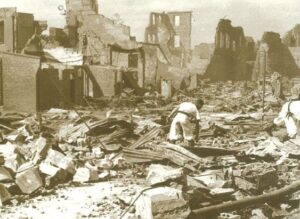 February 3, 1931, dawned beautiful and calm in Hawke’s Bay, New Zealand, but by the end of the day, few people would be thinking of how the day had started out. At exactly 10:47am the hands of the clock on the band rotunda in Napier stopped turning. That was the moment when the area was hit by a massive 7.8 magnitude earthquake. The quake shook the area for a full three minutes, causing such destruction that it actually changed the topography of the area forever. Buildings were leveled, streets were destroyed, fires broke out, power and phone lines were knocked out, and 256 people lost their lives…161 in Napier, 93 in Hastings, and two in Wairoa. Many thousands more were injured. The 1931 Hawke’s Bay earthquake the deadliest natural disaster in New Zealand’s history.
February 3, 1931, dawned beautiful and calm in Hawke’s Bay, New Zealand, but by the end of the day, few people would be thinking of how the day had started out. At exactly 10:47am the hands of the clock on the band rotunda in Napier stopped turning. That was the moment when the area was hit by a massive 7.8 magnitude earthquake. The quake shook the area for a full three minutes, causing such destruction that it actually changed the topography of the area forever. Buildings were leveled, streets were destroyed, fires broke out, power and phone lines were knocked out, and 256 people lost their lives…161 in Napier, 93 in Hastings, and two in Wairoa. Many thousands more were injured. The 1931 Hawke’s Bay earthquake the deadliest natural disaster in New Zealand’s history.
The earthquake left the people in shock, as they surveyed the damage to their beautiful seaside city. People had trouble breathing, due to dust clouds from shattered buildings, and the roads were filled with huge splits making it impossible to get emergency equipment into the area. When the initial shaking began, people ran panic-stricken out of the buildings and into the street. Many of them were killed instantly when they were struck by falling masonry, as stone decorations on many buildings crashed to the ground. Still others were buried alive in the rubble as the buildings collapsed. To make matters worse, fires were burning throughout the city of Napier for a full 36 hours before they could be contained. Most of the surviving buildings from the initial impact of the quake, were leveled by the fires. Nearby Hastings lost approximately 200 buildings and most of the deaths there were in a single department store, although many died in the public library too. Hastings also suffered from out-of-control fires due to problems with their water supply, but fires weren’t as bad as in Napier.
While the earthquake was a major tragedy, there were numerous acts of heroism that will never be forgotten.  Water for fighting the fires ran out because underground pipes had cracked and broken. Fire engines at Napier’s central fire station were covered in debris from the destroyed brigade building, and they couldn’t be used when fires broke out in the town anyway. Napier Hospital, built only a year earlier, collapsed, claiming the lives of 12 nurses. Rescuers fought to bring out trapped and injured victims from the rubble before the fires reached them. Still, many died in the terrible inferno. With the loss of the Napier Hospital, first responders quickly set up emergency hospitals. Unfortunately, the hospitals lacked the necessary medical supplies, and so the doctors and nurses were limited in what they could do to help the injured. Back-up medical teams were sent from Auckland on board Navy ships and from Wellington by train, but this took time to arrange, and with communication largely out, the communications had to be routed through ships in the harbor, like the HMS Veronica, which had just tied up in the harbor when the quake hit. At first her captain thought there had been an explosion on board…until he saw the wharf twisting and beyond it houses and other buildings crumpling to the ground. It was then that the sickening reality hit him. He quickly sent his sailors ashore to assist with the rescue effort. By the morning of February 4, 1931, the area was filled with rescue workers trying to save anyone they could. Unfortunately, for many, help came too late. Still, a full three days after the quake a 90-year-old man who was buried in the earthquake rubble was finally dug out alive. Miracles do happen.
Water for fighting the fires ran out because underground pipes had cracked and broken. Fire engines at Napier’s central fire station were covered in debris from the destroyed brigade building, and they couldn’t be used when fires broke out in the town anyway. Napier Hospital, built only a year earlier, collapsed, claiming the lives of 12 nurses. Rescuers fought to bring out trapped and injured victims from the rubble before the fires reached them. Still, many died in the terrible inferno. With the loss of the Napier Hospital, first responders quickly set up emergency hospitals. Unfortunately, the hospitals lacked the necessary medical supplies, and so the doctors and nurses were limited in what they could do to help the injured. Back-up medical teams were sent from Auckland on board Navy ships and from Wellington by train, but this took time to arrange, and with communication largely out, the communications had to be routed through ships in the harbor, like the HMS Veronica, which had just tied up in the harbor when the quake hit. At first her captain thought there had been an explosion on board…until he saw the wharf twisting and beyond it houses and other buildings crumpling to the ground. It was then that the sickening reality hit him. He quickly sent his sailors ashore to assist with the rescue effort. By the morning of February 4, 1931, the area was filled with rescue workers trying to save anyone they could. Unfortunately, for many, help came too late. Still, a full three days after the quake a 90-year-old man who was buried in the earthquake rubble was finally dug out alive. Miracles do happen.
Napier was forever changed from this devastating tragedy. The Ahuriri Lagoon and tidal flats that was once a large body of water was completely emptied, and today the area is the site of the Hawke’s Bay Airport. The sea floor just off Hawke’s Bay was lifted approximately 8 feet 10 inches. The main fault, which was buried under the earth’s surface heaved up the land, setting off two smaller faults which broke on the surface. Following the terrible devastation, came resilience and determination in the people, and the area would be rebuilt and 
 improved. The streets were widened when they rebuilt, and services were improved, including New Zealand’s first underground power system. The architectural fashion of the time was known as Art Deco, and central Napier is almost entirely built in variations of this style. One beautiful legacy from an otherwise tragic chapter of Napier’s history.
improved. The streets were widened when they rebuilt, and services were improved, including New Zealand’s first underground power system. The architectural fashion of the time was known as Art Deco, and central Napier is almost entirely built in variations of this style. One beautiful legacy from an otherwise tragic chapter of Napier’s history.

 My sister-in-law, Jennifer Parmely is a busy person in just about every way. Jennifer is a labor and delivery nurse who is close to retirement. I sometimes find myself amazed that she can possible have been helping to deliver babies for about 40 years now. She has assisted in the delivery of more babies than I’m sure even she knows or could count. It’s a lot of years of deliveries, some of which were her own grandnieces and grandnephews. I know that my girls, Corrie Petersen and Amy Royce were both very thankful to have their aunt in the room with them when they gave birth, and so was I. It’s hard to watch your kids go through so much pain, and it is comforting to know that their aunt, who was a delivery room nurse, and who cared about my kids, was there with them during one of the hardest times in their lives, even if they were also the happiest moments of their lives. Jennfer has been that blessing to so many people, friends, family, and strangers, and all of them are so thankful.
My sister-in-law, Jennifer Parmely is a busy person in just about every way. Jennifer is a labor and delivery nurse who is close to retirement. I sometimes find myself amazed that she can possible have been helping to deliver babies for about 40 years now. She has assisted in the delivery of more babies than I’m sure even she knows or could count. It’s a lot of years of deliveries, some of which were her own grandnieces and grandnephews. I know that my girls, Corrie Petersen and Amy Royce were both very thankful to have their aunt in the room with them when they gave birth, and so was I. It’s hard to watch your kids go through so much pain, and it is comforting to know that their aunt, who was a delivery room nurse, and who cared about my kids, was there with them during one of the hardest times in their lives, even if they were also the happiest moments of their lives. Jennfer has been that blessing to so many people, friends, family, and strangers, and all of them are so thankful.
Jennifer is also an athlete. She hikes, skis, rides bicycles, and also does many indoor forms of exercise there is. 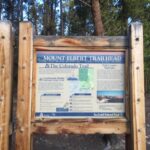
 Jennifer and her partner, Brian Cratty have a cabin on Casper Mountain, so they can be closer to the mountain and activities they love. For them, Casper Mountain is their “happy place.” Jennifer and Brian have hiked many places, including to heights as high as 14,473 feet when they climbed Mount Elbert in Colorado, called a 14er. She has also hiked in Vermont, Maine, and New Zealand…yes, New Zealand. That is a dedicated hiker, and I thought I was. Not nearly as much as Jennifer. I think when Jennifer retires, she will wonder how she had time to work with all of her athletic passions.
Jennifer and her partner, Brian Cratty have a cabin on Casper Mountain, so they can be closer to the mountain and activities they love. For them, Casper Mountain is their “happy place.” Jennifer and Brian have hiked many places, including to heights as high as 14,473 feet when they climbed Mount Elbert in Colorado, called a 14er. She has also hiked in Vermont, Maine, and New Zealand…yes, New Zealand. That is a dedicated hiker, and I thought I was. Not nearly as much as Jennifer. I think when Jennifer retires, she will wonder how she had time to work with all of her athletic passions.
While being a nurse, an athlete, as well as mom of three boys, Barry Schulenberg (married to Kellie), JD Parmely, and Eric Parmely (married to Ashley), keeps Jennifer quite busy, her latest blessings are her grandchildren. Jennifer has three granddaughters, Reagan, Hattie, and Maeve Parmely, and grandson Bowen 
 Parmely…these are the children on her son Eric and his wife Ashley. Jennifer loves to do special things for the kids, like their own special cake for their birthday, taking them on a special shopping trip for their birthdays, and taking turns spending the night with their grandparents. She works hard to make things special for each of them. Jennifer goes by Oma to the kids, which is German for Grandma…a fitting name for a woman of German descent (along with a lot of English). For Jennifer, life is good. Today is Jennifer’s birthday. Happy birthday Jennifer!! Have a great day!! We love you!!
Parmely…these are the children on her son Eric and his wife Ashley. Jennifer loves to do special things for the kids, like their own special cake for their birthday, taking them on a special shopping trip for their birthdays, and taking turns spending the night with their grandparents. She works hard to make things special for each of them. Jennifer goes by Oma to the kids, which is German for Grandma…a fitting name for a woman of German descent (along with a lot of English). For Jennifer, life is good. Today is Jennifer’s birthday. Happy birthday Jennifer!! Have a great day!! We love you!!
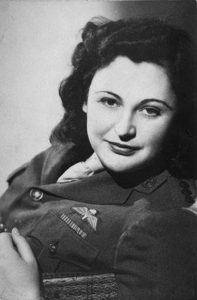 When I think of some of the civilian heroes of our wars, I find myself amazed at the many courageous acts they carried out. They threw caution to the wind and moved about among the enemy, somehow managing to remain almost invisible. They had code names and secret pasts that no one knew about, not even the people they worked with…and definitely not the enemy they worked against.
When I think of some of the civilian heroes of our wars, I find myself amazed at the many courageous acts they carried out. They threw caution to the wind and moved about among the enemy, somehow managing to remain almost invisible. They had code names and secret pasts that no one knew about, not even the people they worked with…and definitely not the enemy they worked against.
One of these spies was Nancy Grace Augusta Wake, who was also known by her married name, Nancy Fiocca. Wake was a New Zealand-born nurse and journalist, who joined the French Resistance and later the Special Operations Executive (SOE) during World War II. Born August 30, 1912 in Roseneath, Wellington, New Zealand, the youngest of the six children of Charles Augustus Wake and Ella Rosieur Wake. In 1914, the family moved to Australia and settled at North Sydney. Shortly thereafter, Wake’s father returned to New Zealand and her mother raised the children. In Sydney, Wake attended the North Sydney Household Arts (Home Science) School.
At the age of 16, she ran away from home and worked as a nurse. With £200 (about $255.27) that she had inherited from an aunt, she traveled to New York City, then London where she trained herself as a journalist. In the 1930s, she worked in Paris and later for Hearst newspapers as a European correspondent. She witnessed the rise of Adolf Hitler and the Nazi movement and “saw roving Nazi gangs randomly beating Jewish men and women in the streets” of Vienna. The Nazi movement repulsed her.
In 1937, Wake met wealthy French industrialist Henri Edmond Fiocca, whom she married on November 30, 1939. They were living in Marseille, France when Germany invaded. During the war in France, Wake served as an ambulance driver. After the fall of France in 1940, she joined the French Resistance, working in the escape network of Captain Ian Garrow, which became the Pat O’Leary Line. Wake had an incredible ability to elude capture, which earned her the nickname, “White Mouse” by the Gestapo. The Resistance exercised caution with her missions, because her life was in constant danger. The Gestapo tapped her telephone and intercepted her mail. In spite of the danger, Wake said, “I don’t see why we women should just wave our men a proud goodbye and then knit them balaclavas.” As a member of the escape network, she helped Allied airmen evade capture by the Germans and escape to neutral Spain.
In November 1942, Wehrmacht troops occupied the southern part of France after the Allies’ Operation Torch had started. This gave the Germans and the Gestapo unrestricted access to all parts of Vichy France and made life more dangerous for Wake. When the network was betrayed that same year she decided to flee France. Her husband, Henri Fiocca, stayed behind. He later was captured, tortured, and executed by the Gestapo. She threw caution to the wind. She would “doll” herself up and be very flirtatious, almost daring them to search her. She took a chance, and they couldn’t see past her façade to the ruthless spy beneath the beauty she showed on the outside.
In 1943, when the Germans became aware of her, she escaped to Spain and continued on to the United Kingdom. After reaching Britain, Wake joined the Special Operations Executive (SOE) under the code name Hélène. On April 29-30, 1944 as a member of a three person SOE team code-named “Freelance,” Wake parachuted into the Allier department of occupied France to liaise between the SOE and several Maquis groups in the Auvergne region, which were loosely overseen by Emile Coulaudon (code name “Gaspard”). She participated in a battle between the Maquis and a large German force in June 1944. In the aftermath of the battle, she bicycled 500 kilometers to send a situation report to SOE in London. In early 1943, in the process of getting out of France, Wake was picked up with a whole trainload of people and was arrested in Toulouse, but was released four days later. The head of the O’Leary Line, Albert Guérisse, managed to have her released by claiming she was his mistress and was trying to conceal her infidelity to her husband (all of which was untrue). She succeeded in crossing the Pyrenees to Spain. Until the war ended, she was unaware of her husband’s death, and she subsequently blamed herself for it. Wake was a recipient of the George Medal from the United Kingdom, the Medal of Freedom from the United States, the Legion of Honor from France, and medals from Australia and New Zealand.
In 1985, Wake published her autobiography, “The White Mouse.” Later, after 40 years of marriage, her second husband John Forward died at Port Macquarie on 19 August 1997. The couple had no children. Wake sold her medals to fund herself saying, “There was no point in keeping them, I’ll probably go to hell and they’d melt anyway.” Strangely, this disregard of the value of war medals, seemed common among the war spies. In 2001, Wake left Australia for the last time and emigrated to London. She became a resident at the Stafford Hotel in Saint James’ Place, near Piccadilly, formerly a British and American forces club during the war. She had been introduced to her first “bloody good drink” there by Louis Burdet, the general manager at the time, who had  also worked for the Resistance in Marseille. Mornings usually found Wake in the hotel bar, sipping her first gin and tonic of the day. She was welcomed at the hotel, celebrating her ninetieth birthday there. Out of deep respect for her, the hotel owners absorbed most of the costs of her stay. In 2003, Wake chose to move to the Royal Star and Garter Home for Disabled Ex-Service Men and Women, in Richmond, London, where she remained until her death on Sunday evening August 7, 2011, aged 98, at Kingston Hospital, where she had been admitted with a chest infection. She had requested that her ashes be scattered at Montluçon in central France. Her ashes were scattered near the village of Verneix, which is near Montluçon, on March 11, 2013.
also worked for the Resistance in Marseille. Mornings usually found Wake in the hotel bar, sipping her first gin and tonic of the day. She was welcomed at the hotel, celebrating her ninetieth birthday there. Out of deep respect for her, the hotel owners absorbed most of the costs of her stay. In 2003, Wake chose to move to the Royal Star and Garter Home for Disabled Ex-Service Men and Women, in Richmond, London, where she remained until her death on Sunday evening August 7, 2011, aged 98, at Kingston Hospital, where she had been admitted with a chest infection. She had requested that her ashes be scattered at Montluçon in central France. Her ashes were scattered near the village of Verneix, which is near Montluçon, on March 11, 2013.
 The Gallipoli campaign took place between April 1915 and December 1915 in an effort to take the Dardanelles from the Turkish Ottoman Empire…an ally of Germany and Austria, and thus force it out of the war. About 60,000 Australians and 18,000 New Zealanders were part of a larger British force. Among the wounded were some 26,000 Australians and 7,571 New Zealanders, while 7,594 Australians and 2,431 New Zealanders were killed. Numerically, Gallipoli was a minor campaign, but it took on considerable national and personal importance to the Australians and New Zealanders who fought there.
The Gallipoli campaign took place between April 1915 and December 1915 in an effort to take the Dardanelles from the Turkish Ottoman Empire…an ally of Germany and Austria, and thus force it out of the war. About 60,000 Australians and 18,000 New Zealanders were part of a larger British force. Among the wounded were some 26,000 Australians and 7,571 New Zealanders, while 7,594 Australians and 2,431 New Zealanders were killed. Numerically, Gallipoli was a minor campaign, but it took on considerable national and personal importance to the Australians and New Zealanders who fought there.
The Gallipoli Campaign was Australia’s and New Zealand’s introduction to the Great War. Many Australians and New Zealanders fought on the Peninsula from the day of the landings (April 25, 1915) until the evacuation on December 20, 1915. The 25th April is the New Zealand equivalent of Armistice Day and is marked as the ANZAC day in both countries with Dawn Parades and  other services in every city and town. Shops are closed in the morning. It is a very important day to Australians and New Zealanders for a variety of reasons that have changed and transmuted over the years. This campaign, while small in losses, was huge in the hearts of the Australians and New Zealanders.
other services in every city and town. Shops are closed in the morning. It is a very important day to Australians and New Zealanders for a variety of reasons that have changed and transmuted over the years. This campaign, while small in losses, was huge in the hearts of the Australians and New Zealanders.
While many losses came out of this campaign, it seems that there were two who were saved…potentially anyway. After the campaign was over, and people were wandering the area, someone came across an unusual, and seriously rare, find. There on the ground were two bullets that had collided with each other in mid-air, thus saving the lives of the two combatants who fired the rounds. Obviously, they could have been hit by another round, in which case the mid-air collision only slightly prolonged their lives. At least this scenario might be what you would think. The reality is that you would be wrong. Taking a look closer at the bullets, it is quite obvious that one round collided with 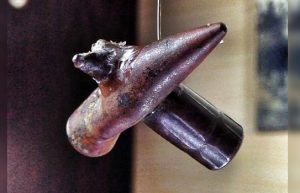 another. But the round on the left doesn’t have any rifling on it, whereas the round on the right does. They collided, but in reality, the round on the left probably wasn’t moving as fast as an actual speeding bullet. Maybe it was part of a clip on an ANZAC soldiers webgear as he was in an attack, or some other bizarre reason. But this most certainly wasn’t the intersection of two trajectories between the lines…making such a collision between two bullets even more rare. Nevertheless, the picture itself is quite interesting, and would have caught the eye of anyone looking at it. How they got there really makes no difference, but the fact that they were found on the Gallipoli battlefield makes them an interesting find. If you ask me, it is still a very rare occurrence.
another. But the round on the left doesn’t have any rifling on it, whereas the round on the right does. They collided, but in reality, the round on the left probably wasn’t moving as fast as an actual speeding bullet. Maybe it was part of a clip on an ANZAC soldiers webgear as he was in an attack, or some other bizarre reason. But this most certainly wasn’t the intersection of two trajectories between the lines…making such a collision between two bullets even more rare. Nevertheless, the picture itself is quite interesting, and would have caught the eye of anyone looking at it. How they got there really makes no difference, but the fact that they were found on the Gallipoli battlefield makes them an interesting find. If you ask me, it is still a very rare occurrence.
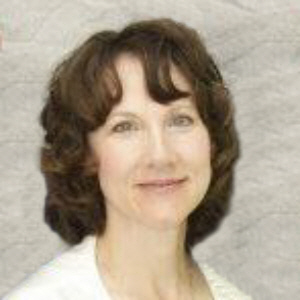 My sister-in-law, Jennifer Parmely is a complex woman, who leads a busy life. She is an obstetrics nurse by trade, but that is just her career, albeit a very satisfying one for her. Jennifer knew when she was just 17 years old, that she wanted to be a nurse, and before long, she knew that she wanted to help bring life into the world. She has never changed her mind about that, and has been a nurse at Wyoming Medical Center for about 36 years now. That adds up to a whole lot of babies who can say that Jennifer was there the day they were born. She was the nurse who assisted in the births of all four of my grandchildren. It was very comforting to have her there.
My sister-in-law, Jennifer Parmely is a complex woman, who leads a busy life. She is an obstetrics nurse by trade, but that is just her career, albeit a very satisfying one for her. Jennifer knew when she was just 17 years old, that she wanted to be a nurse, and before long, she knew that she wanted to help bring life into the world. She has never changed her mind about that, and has been a nurse at Wyoming Medical Center for about 36 years now. That adds up to a whole lot of babies who can say that Jennifer was there the day they were born. She was the nurse who assisted in the births of all four of my grandchildren. It was very comforting to have her there.
While nursing is Jennifer’s career, exercise is her passion. She loves all forms of 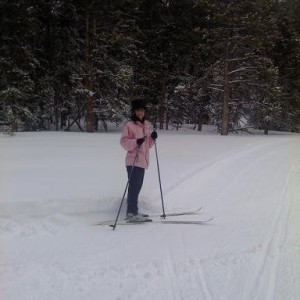 exercise, both indoor and outdoor. I think that like many of us in the family, she loves to hike. She takes trips to different areas to hike. She has been to New Zealand, Colorado, and today, she and her boyfriend, Bryan are on their way to Arizona to do some hiking there. She hiked a mountain with Bryan a while back in Colorado that was 14,000 feet high. That is an amazing feat for anyone. I have done quite a bit of hiking, but I have never gone to that altitude, so I am curious about how I would do. Jennifer and Brian did very well, but they saw people around them who were having some difficulty breathing deeply. I suppose it all depends on the shape you are in and the lung capacity you have. I don’t know where in Arizona they plan to go hiking, but since I have been in Arizona a number of times and hiked there too, I
exercise, both indoor and outdoor. I think that like many of us in the family, she loves to hike. She takes trips to different areas to hike. She has been to New Zealand, Colorado, and today, she and her boyfriend, Bryan are on their way to Arizona to do some hiking there. She hiked a mountain with Bryan a while back in Colorado that was 14,000 feet high. That is an amazing feat for anyone. I have done quite a bit of hiking, but I have never gone to that altitude, so I am curious about how I would do. Jennifer and Brian did very well, but they saw people around them who were having some difficulty breathing deeply. I suppose it all depends on the shape you are in and the lung capacity you have. I don’t know where in Arizona they plan to go hiking, but since I have been in Arizona a number of times and hiked there too, I 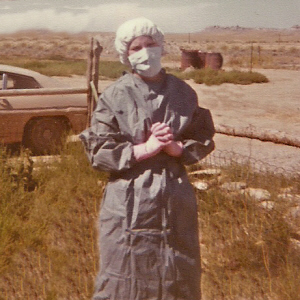 would absolutely recommend the Grand Canyon. We didn’t hike very far in, but the areas we were in were amazing. The next time I go, I want to hike down to the river. I know that wherever they hike, they will have a great time.
would absolutely recommend the Grand Canyon. We didn’t hike very far in, but the areas we were in were amazing. The next time I go, I want to hike down to the river. I know that wherever they hike, they will have a great time.
In many ways, Jennifer’s love of all things healthy has made her not only a nurse helping to bring life into the world, but also a person keeping her own life as strong and healthy as it can be. It’s a great way to live and one that will keep Jennifer, the grandma, in the lives of her three little grandchildren, Reagan, Hattie, and Bowen Parmely, for a long time to come. Today is Jennifer’s birthday. Happy birthday Jennifer!! Have a great day!! We love you!!
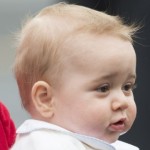 It’s been a fast year in the royal family. Little Prince George has wowed everyone he met. He is a sweet little boy who’s parents’ hands on style has proven to be pretty perfect for bringing up a happy and well mannered little prince. Every time I see his little smile I have to smile too. He is just so cute. We all knew that his handsome parents would produce a handsome little boy, and we were not disappointed. Prince George did not come home to the palace after his birth, but rather went to visit he mother’s family for a time…a very unusual event, and one that the royals really didn’t like. I suppose that like all grandparents, they worried, but this family worried about Prince George’s safety. He was, after all, a very famous boy…even before he was born, and that makes for possible threats to his safety. Nevertheless, while security was high outside, the family had their privacy inside.
It’s been a fast year in the royal family. Little Prince George has wowed everyone he met. He is a sweet little boy who’s parents’ hands on style has proven to be pretty perfect for bringing up a happy and well mannered little prince. Every time I see his little smile I have to smile too. He is just so cute. We all knew that his handsome parents would produce a handsome little boy, and we were not disappointed. Prince George did not come home to the palace after his birth, but rather went to visit he mother’s family for a time…a very unusual event, and one that the royals really didn’t like. I suppose that like all grandparents, they worried, but this family worried about Prince George’s safety. He was, after all, a very famous boy…even before he was born, and that makes for possible threats to his safety. Nevertheless, while security was high outside, the family had their privacy inside.
Prince George is already a world traveler, having traveled to New Zealand and Australia with  his parents at just 9 months of age…one of the youngest princes to travel abroad. Something that not everyone can say they did in their first year, but then Prince George is a special boy. He is the future king of England, behind his grandfather and his dad. He has many things to learn, and there is no time like the present to begin. He will be expected to act in a certain way, and smile even when he doesn’t feel like it. He will be expected to be at least tolerant of
his parents at just 9 months of age…one of the youngest princes to travel abroad. Something that not everyone can say they did in their first year, but then Prince George is a special boy. He is the future king of England, behind his grandfather and his dad. He has many things to learn, and there is no time like the present to begin. He will be expected to act in a certain way, and smile even when he doesn’t feel like it. He will be expected to be at least tolerant of
the press, and if he is like his parents, he will do so with winning style. He will host many events himself, such as the opportunity he had recently, to have a play dates with some children at the residence of the Queen…who was away at the time. Not everyone could get away with that, but then Prince George holds a special place in the heart of the Queen. I don’t say he could get away with just anything with her, but maybe more than most kids could.
While he is still a baby, Prince George will soon have royal obligations like all the other royal 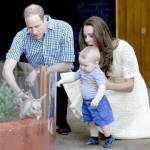 family members. When you are a royal, people expect you to make appearances at different has a lot learn, but he has a while for that yet. Right now, all Prince George needs to do is show us the cute little faces he makes, and we’ll be satisfied. It’s always a bit sad to realize that before we know it Prince George…like all babies with grow up and those baby days will be long gone, but for now, we can enjoy his smiley face for a little while longer. In the years to come, Prince George will be an integral part of the royal family and their face to the world, but for now, he is very much a little boy, and I hope he gets some time to be just a little boy. Happy 1st birthday Prince George…my 18th cousin twice removed!!
family members. When you are a royal, people expect you to make appearances at different has a lot learn, but he has a while for that yet. Right now, all Prince George needs to do is show us the cute little faces he makes, and we’ll be satisfied. It’s always a bit sad to realize that before we know it Prince George…like all babies with grow up and those baby days will be long gone, but for now, we can enjoy his smiley face for a little while longer. In the years to come, Prince George will be an integral part of the royal family and their face to the world, but for now, he is very much a little boy, and I hope he gets some time to be just a little boy. Happy 1st birthday Prince George…my 18th cousin twice removed!!
 My sister-in-law, Jennifer Parmely, loves to hike. That is something Bob and I can totally relate to. There is just something wonderful about being on a trail in the woods, listening to the birds singing and seeing the beauty of the green trees. Most hikers like to find trails wherever they travel, and Jennifer, Bob and I are no exception. Jennifer has hiked many of the usual places around Casper, like the Bridle Trail on the mountain, and of course, the Platte River Parkway, but she has also hiked places in Colorado, and as far away as New Zealand. Now that would be my kind of hiking trip to take.
My sister-in-law, Jennifer Parmely, loves to hike. That is something Bob and I can totally relate to. There is just something wonderful about being on a trail in the woods, listening to the birds singing and seeing the beauty of the green trees. Most hikers like to find trails wherever they travel, and Jennifer, Bob and I are no exception. Jennifer has hiked many of the usual places around Casper, like the Bridle Trail on the mountain, and of course, the Platte River Parkway, but she has also hiked places in Colorado, and as far away as New Zealand. Now that would be my kind of hiking trip to take.
Jennifer’s love of hiking came about when she decided to get into better shape, and it is really all part of a package of things she does to stay in great shape. She skis, runs, hikes, and bikes for exercise. With a broad range of activities that she likes, she doesn’t have to go to the gym to workout, although she might do that too, for all I know. Many people would call Jennifer an exercise fanatic, and I suppose they would be right, but if you want to be in good shape, you have to do what it takes to get to that place.
Jennifer is an Obstetrics Nurse, working with mothers in labor, and in the nursery with their babies. It is a job that started when she became a candy stripper at the young age of 17 years, and one that she does very well. My girls, Corrie and Amy, and I have been very glad to have her there when the time came for their babies to arrive. She is very good at her job, and has a very calming effect on a young mother who is a little apprehensive about the impending birth of their child. Having a baby is no easy task, and when you have a nurse there who is so confident and capable, it makes the process much easier. Her hours are long, but the nice thing is that she doesn’t have to work as many days a week to get her hours in…something all of us might have liked to do, at one time or another.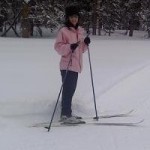
Then, as if her life isn’t packed full of activities, Jennifer also takes piano lessons, and spends time practicing the piano. I suppose you would call this a well rounded life, and of course, you would be right. I think her activity filled life really started when she decided to get into shape all those years ago. You can’t have such a busy life, if you are too tired to get out there and just do it. Jennifer has proven that if you are determined, you can get back to good shape and you can do all the activities you want to. You just have to go for it. Today is Jennifer’s birthday, Happy birthday Jennifer!! Have a great day!! We love you!!

